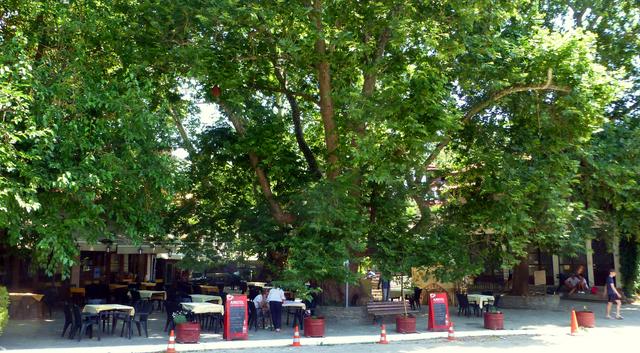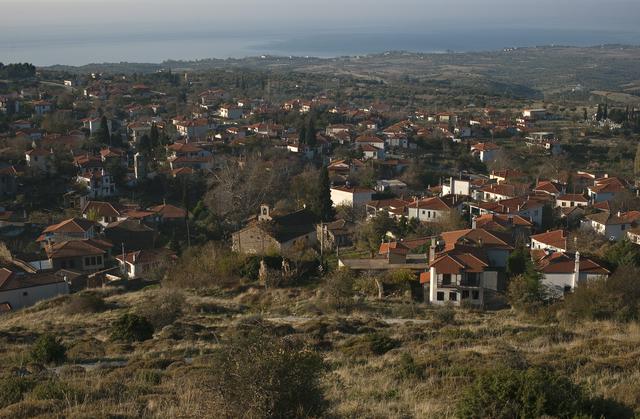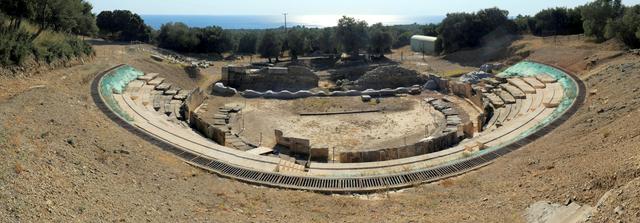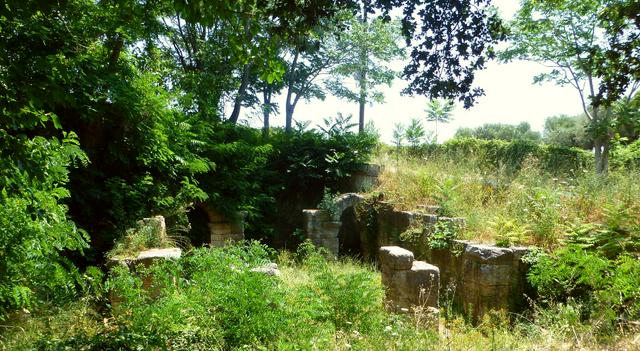Maroneia is a village in Western Thrace.

 Maroneia was one of the wealthiest towns of ancient world along with nearby Abdera and Mesimvria. Nowadays it's a village appreciated for its surrounding beaches (Profitis Ilias, Alkyona, Mesi, Kageles and Molyvoti). The settlement of Maronia spread over a vast area at the foot of Mount Ismaros. Several ancient monuments are excarved but others are still hidden throughout the olive groves and the mountainous landscapes of Ismaro.
Maroneia was one of the wealthiest towns of ancient world along with nearby Abdera and Mesimvria. Nowadays it's a village appreciated for its surrounding beaches (Profitis Ilias, Alkyona, Mesi, Kageles and Molyvoti). The settlement of Maronia spread over a vast area at the foot of Mount Ismaros. Several ancient monuments are excarved but others are still hidden throughout the olive groves and the mountainous landscapes of Ismaro.
Maroneia was founded in the mid-7th century B.C. on the slopes of Ismaros and soon developed into a prosperous and densely inhabited centre. Maroneia was close to the acient town of Ismaros, mentioned by Homer in the Odyssey. Some scholars identify Maroneia with his Ismaros. Homer has Odysseus plundering the city but sparing Maron, whom he identifies as a priest of Apollo. Maron presents Odysseus with a gift of wine, as well as with gold and silver. The strong wine was later used by him to numb the Cyclops. During the Classical period, the city had a strong fortification wall, 10 km long, from the coast up to the top of Ismaros. Maroneia was the largest and most important of all ancient Greek colonies of Western Thrace. In the following centuries, under different rulers (Mazedonians, Romans, Byzantine), it prospered and was and important harbour town, but finally lost its importance in the late Byzantine and Ottoman periods.


- Ancient Theatre. It was constructed in the Hellenistic period and restructured in Roman times. The three rows of stone seats are still visible. It was partly renovated during last years. If you follow the dirt road for another 2 km, you come into a landscape with strange, big round rocks, reminiscent of erratic blocks. You should not miss it once you are in this area.
- Gate of Hadrian. Built in honor of the Roman emperor Hadrian, when he visited Maronia in 124-125 AD
- Cave of Maronia. You need a guide to visit this cave mentioned by Apollonio in his work "Argonautics".
- West Wall of ancient Ismara. Hidden between olive trees in a nice surrounding; it's worth to drive along the few km of bad dirt road
- Mesimvria archaeological site. Mesimvria was a colony of the inhabitants of the island Samothrace, built at the end of the 7th century BC. The city flourished in the 5th and 4th century BC. During the period of the Macedonian and later Roman rule it began to loose importance, as the construction of roads in the hinterland lowered the importance of the coastal city and it's harbour. On the excavation site, the remains of the fortress wall with towers, private houses, a road network, public buildings, a sanctuary of Demeter and an Apollo temple were found. The most important monuments of the excavation site are: 1) The Shrine of Demeter. Inside the building, silver, gold, silver and gilded relief panels were found, all connected to the Demeter cult, dated to the 4th century BC. 2) The archaic temple of Apollo. It was part of a larger building complex (35 x 45 m) with a central paved courtyard, surrounded by a stoa. Many ceramic fragments with engraved inscriptions were inside the temple from the 6th and 5th centuries BC. Found.
Ancient Theatre. It was constructed in the Hellenistic period and restructured in Roman times. The three rows of stone seats are still visible. It was partly renovated during last years. If you follow the dirt road for another 2 km, you come into a landscape with strange, big round rocks, reminiscent of erratic blocks. You should not miss it once you are in this area.
Gate of Hadrian. Built in honor of the [[Roman Empire|Roman emperor]] Hadrian, when he visited Maronia in 124-125 AD
Cave of Maronia. You need a guide to visit this cave mentioned by Apollonio in his work "Argonautics".
West Wall of ancient Ismara. Hidden between olive trees in a nice surrounding; it's worth to drive along the few km of bad dirt road
Mesimvria archaeological site. Mesimvria was a colony of the inhabitants of the island [[Samothrace]], built at the end of the 7th century BC. The city flourished in the 5th and 4th century BC. During the period of the Macedonian and later Roman rule it began to loose importance, as the construction of roads in the hinterland lowered the importance of the coastal city and it's harbour. On the excavation site, the remains of the fortress wall with towers, private houses, a road network, public buildings, a sanctuary of Demeter and an Apollo temple were found. The most important monuments of the excavation site are: 1) The Shrine of Demeter. Inside the building, silver, gold, silver and gilded relief panels were found, all connected to the Demeter cult, dated to the 4th century BC. 2) The archaic temple of Apollo. It was part of a larger building complex (35 x 45 m) with a central paved courtyard, surrounded by a stoa. Many ceramic fragments with engraved inscriptions were inside the temple from the 6th and 5th centuries BC. Found.
- Swimming. from Fanari in the west to Platanitis near Maronia, endless beautiful, uncrowded sandy beaches line up.
Swimming. from Fanari in the west to Platanitis near Maronia, endless beautiful, uncrowded sandy beaches line up.
The area was once famous for its wine in antique times, but there is still wine production, and it's worth to try the local wine.
- Fish Tavern "Gianna and Roula". simple tavern near the harbour
- Stratos Tavern. at the harbour, with nice view over the sea
- Maronia Central Square. There are several nice restaurants around the central square, in the shade, under big trees.
Fish Tavern "Gianna and Roula". simple tavern near the harbour
Stratos Tavern. at the harbour, with nice view over the sea
Maronia Central Square. There are several nice restaurants around the central square, in the shade, under big trees.
Best places to have a drink in a relaxed environment is at the restaurants at the harbour mentionend above or at one of the beach bars up to Krioneri village.
- Alexandroupolis
- Samothrace Island
- Thasos Island
- Komotini
- Kavala
